Top 15 Deadliest Poisons
DeadJosey (YouTube)
When discussing the methods of murder and mayhem it would be impossible to overlook one of the oldest methods of murder known – Poisoning.
Poisons have been used as a means for murder since the beginning of written history. As man became more civilized and criminal investigation more clever, poisons allowed an almost untraceable way to get rid of enemies or even unwanted husbands or wives. So what exactly is a poison and how does it work from a chemistry standpoint?
Poisons are compounds that when ingested, absorbed, injected or inhaled cause disruption of normal body function usually through chemical reactions or activities on the molecular scale.
The lethality of poisons is given on a scale called the LD50 which is the lethal dose for 50% of the population. Even substances not thought of as poisons can be lethal if taken in improper dosages.

There are four pathways by which poisons enter the body:
- Ingestion (Gastrointestinal Tract)
- Inhalation (Lungs)
- Dermal/Topical (Skin)
- Injection (intravenous, intramuscular, intraperitoneal)
Not all pathways are equally effective. The speed with which a poison can act is dependent on the pathway it takes into the body. The pathways are listed below from fastest to slowest:
Intravenous (into a vein) injection > inhalation > intraperitoneal (into the body) injection > intramuscular (into the muscle) injection> ingestion > topical (onto the skin) absorption
Some poisons are not fast acting no matter how they are administered. Poisons are also categorized by their speed of action:
| Acute | < 24hr | usually 1 exposure |
| Sub-acute | 1 month | repeated doses |
| Sub-chronic | 1-3mo | repeated doses |
| Chronic | > 3mo | repeated doses |
Over the exposure time, the concentration of poison in the body can build up, it can redistribute, or it can overwhelm repair and removal mechanisms.
Absorption
Once the poison is in the body, it has to overcome or avoid the body’s natural defenses and translocate to the area in which it will act.
When inhaled a poison is in gas form and uses the body’s blood stream to move through the body as absorbed gases though the alveoli.
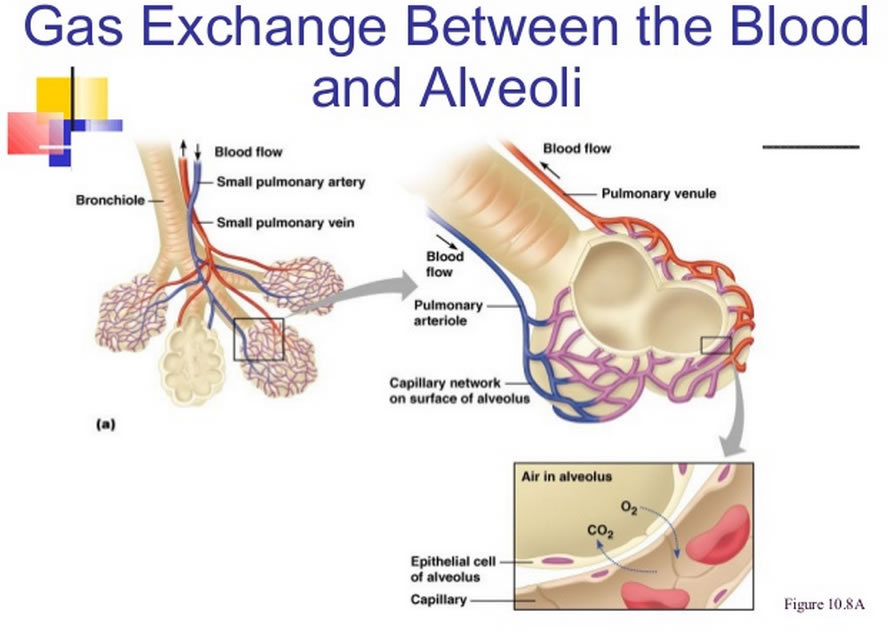
When ingested the poison is absorbed through the GI tract and small intestine.
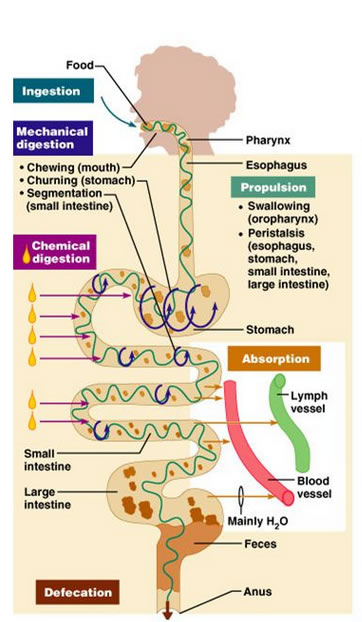
When absorbed through the skin the toxin passes first through the pores, then into the subcutaneous tissues and then finally into the blood stream.

Distribution
Distribution refers to how the poison is translocated through the body once absorbed. In most cases, transport occurs through blood flow. The rate of distribution is therefore dependent on blood flow and the chemical characteristics of the poison. (I.e. if it has a high affinity for certain tissues distribution throughout the body will be slow). The rate of distribution can vary over time (no pun intended).
Storage and Binding
If the poison is not acute, then the poison must build up over time. Storage in adipose tissue (fat) will occur for those chemical compounds that are non-polar in nature.
In some cases, especially those involving heavy metals, the poisons may be bound in the bones of the victim. Chemicals that are similar in nature to Calcium- e.g. Fluoride (F), Lead (Pb), and Strontium (Sr) find chemical pathways that will imbed them into bone using the body’s natural bone building apparati.
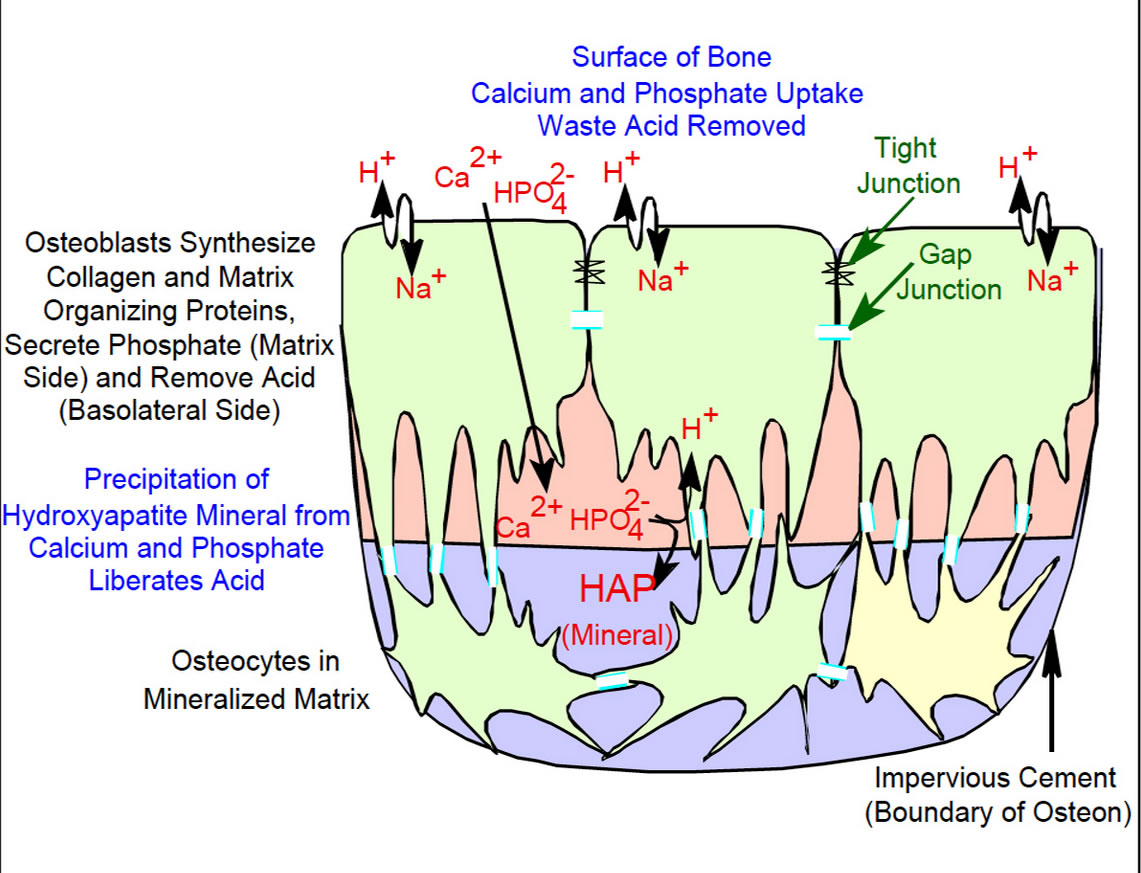
Bone Growth
The damaging effects of a poison is dependent upon getting the concentration of active compound at the target site for enough time. Not all target organs are affected equally. Those organs like the liver, kidneys and lungs have very high blood flow and are therefore more susceptible.
Poisons have many mechanisms by which they can cause damage or death and the damage can occur at the molecular, cellular or organ level. Molecularly, a poison can interact with protein, lipids or DNA pathways. At the cellular level, the poison can
- interfere with receptor-ligand binding
- interfere with membrane function
- interfere with cellular energy production
- bind to biomolecules
- perturb homeostasis
Two specific kinds of poisons will be discussed in this lecture: Toxins and Heavy Metals
Toxins are poisons that are produced by natural biological function; e.g. a snake’s venom.
Heavy metals are the transition metals found in the periodic table.
Toxins
There are three main types of toxin:
- Neurotoxins
- Cytotoxins
- Hemotoxins
Toxins are categorized based on the system within the body they affect. Neurotoxins affect the nervous system, cytotoxins affect cells and hemotoxins effect blood and organs. The way each of these toxins interact with the body is biochemically unique.
Neurotoxins are by far the deadliest of the toxins. Since they target and destroy nerves they can cause paralysis, seizures and death. Some chemicals that fall into the category of a neurotoxin are listed below:
- Lead
- Ethanol (drinking alcohol)
- Glutamate
- Nitric oxide (NO)
- Botulinum toxin (e.g. Botox)
- Tetanus toxin
- Tetrodotoxin (Pufferfish Toxin)
Pufferfish

What? I'm a killer??? Say it isn't so...
Some of the items on this list are probably familiar and surprising since you would not normally think of ethanol as a toxin but at sufficient dosage it can cause death. The last chemical on the list is the poison from puffer fish and is most likely the only chemical on the list you would normally associate with being a poison. But each of the chemicals can in fact do damage to the nerves in your body so they qualify as toxins.
Mechanism of Action
Hemotoxin and neurotoxin affect the body
Adoraim Adoram (YouTube)
Neurotoxins have a number of mechanisms by which they inhibit normal neuron cellular processes. These processes include but are not limited to membrane depolarization and inter-neuron communication pathways. The neurotoxin causes death by binding to and keeping nerve cells from performing their normal activities. When the nerve cells become damaged the body sends signals that cause cellular apoptosis or self-death. The damaged pathways lead to complete nervous system shut down and since nerve signals are what tell our heart to beat and lungs to inhale death soon follows.
The table below shows different types of Neurotoxins and their specific type of inhibition:
| Neurotoxin classification | Neurotoxins |
| Na channel inhibitors | Tetrodotoxin |
| K channel inhibitors | Tetraethylammonium |
| Cl channel inhibitors | Chlorotoxin |
| Ca channel inhibitors | Conotoxin |
| Inhibitors of synaptic vesicle release | Botulinum toxin, tetanus toxin |
| Receptor inhibitors | Bungarotoxin, Curare |
| Receptor agonists | 25I-NBOMe, JWH-018 |
| Blood brain barrier inhibitors | Aluminium, mercury |
| Cytoskeleton interference | Arsenic, ammonia |
| Ca-mediated cytotoxicity | Lead |
| Multiple effects | Ethanol |
| Endogenous neurotoxin sources | Nitric oxide, glutamate |
Looking specifically as Tetrodotoxin as an example, we see that the tetrodotoxin molecule binds to the channels that allow sodium ions the pass into and out of the nerve cell.

Sodium ions are used as part of a "voltage gate" system. Influx of sodium "fires" the neuron to send neutrotransmitters to the brain to signal pain or other reflex actions. With the channels blocked, depolarization is prevented and the nerve cannot propagate the feeling. This would mean the victim of the toxin would lose feeling in that area. As the toxin and thereby the numbness spreads it will eventually reach the lungs or heart causing arrest and then death. Tetrodotoxin is therefore slow acting and painful with death occurring around 3 hours after ingestion if sufficient quantities are consumed.


Cytotoxins
A cytotoxin is any compound or molecule that has a toxic effect on cells. In the world of poisons, the cytotoxins that are most interesting are those contained in the venom of snakes.
Many of the most deadly snakes in the world have cytotoxic venom: Cobras and Adders
Cytotoxic venom contains several digestive enzymes and molecules known as "spreading factors" which cause both local and systemic injury. Locally the venom causes pain, swelling, bleeding and blistering around the bite mark with eventual necrosis (rotting) of the tissue in the area of the bite. Systemically (throughout the body) anti-clotting proteins in the venom can cause system wide bleeding and organ damage.
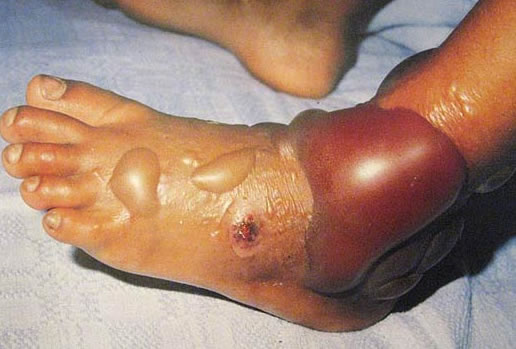
Reaction to a Cobra Bite

Hemotoxin
Hemotoxins are those that destroy red blood cells. Many of the snakes common to the Southern United States are hemotoxic snakes: Cotton Mouths, Rattle Snakes, Copperheads.
The mechanism of this type of toxin is shown below:

The venom itself is what is called a metalloproteinase. Proteinases are capable of breaking down proteins and this one specifically targets the basement membrane of the red blood cell and causes it to lyse. If enough cells lyse, the body hemorrhages.
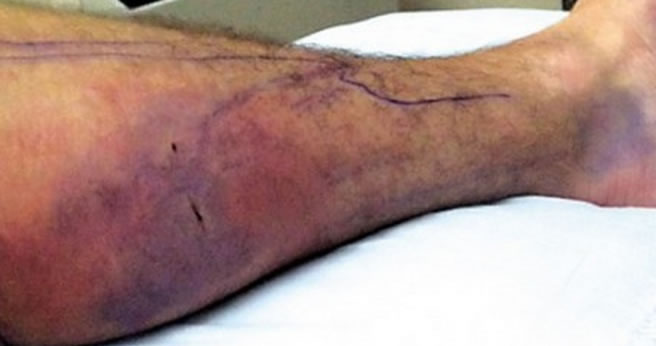
Bruising caused by blood cell ruptures from a Timber Rattlesnake bite.